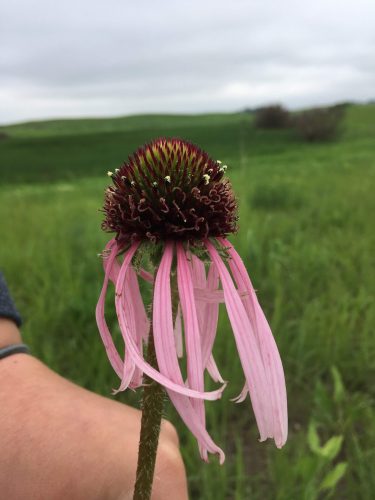
A pallida head. Notice the white pollen, which is the only 100% sure way you can be sure a head is pallida and not angustifolia
Echinacea pallida is an Echinacea species that is not native to Minnesota, but instead ranges East of the range of E angustifolia (and SE of our research site). In the summer of 2018, we identified 96 flowering E. pallida plants with over 200 heads that were planted in a restoration at Hegg Lake WMA. Every year for the past several years, we have visited the E. pallida plants, taken phenology data, and chopped off their heads. We do this to prevent E. pallida from being a bad pollen source or sink for native E. angustifolia populations. We were able to do this early this year, as E. pallida flowers significantly earlier than E. angustifolia.
We went back to check if we missed any heads on in September and found 3. They were done flowering, but hadn’t dropped seeds. We collected those heads, and they are currently stored at CBG. We hope that we might be able to germinate them for tissue. We want to analyze the ploidy of pallida compared to angustifolia. We have sneaking suspicions that pallida may be tetraploid where angustifolia is diploid.
Start year: 2011
Location: Hegg Lake Wildlife Management Area restoration
Overlaps with: Echinacea hybrids (exPt6, exPt7, exPt9), flowering phenology in remnants
Physical specimens: 200+ heads were cut from E. pallida plants and removed then composted. We brought three heads back with us to Chicago Botanic Garden.
Data collected: All pallida data is in demap
GPS points shot: We shot points for all flowering E. pallida plants.
Products: In Fall 2013, Aaron and Grace, externs from Carleton College, investigated hybridization potential by analyzing the phenology and seed set of Echinacea pallida and neighboring Echinacea angustifolia that Dayvis collected in summer 2013. They wrote a report of their study. Pallida counts are being somewhat incorporated into demap.
Previous team members who have worked on this project include: Nicholas Goldsmith (2011), Shona Sanford-Long (2012), Dayvis Blasini (2013), and Cam Shorb (2014)
You can find more information about Echinacea pallida flowering phenology and links to previous flog posts regarding this experiment at the background page for the experiment.

Leave a Reply